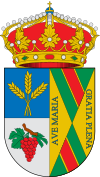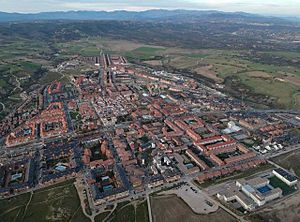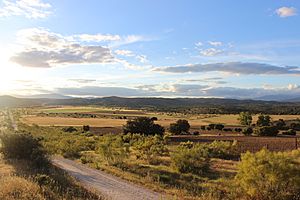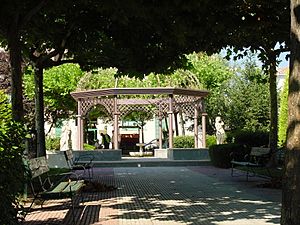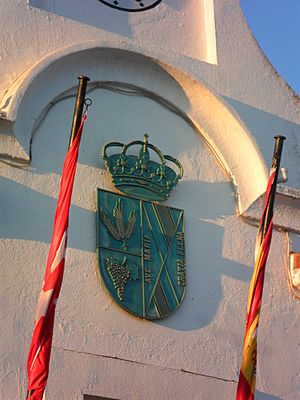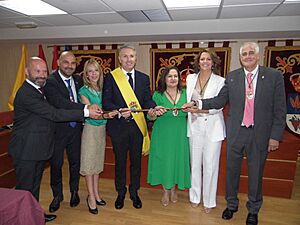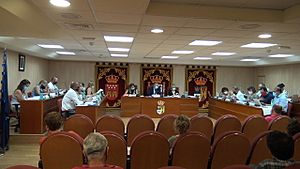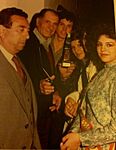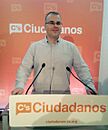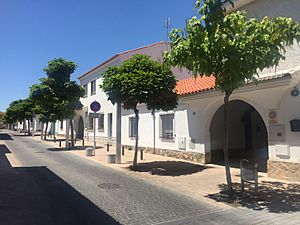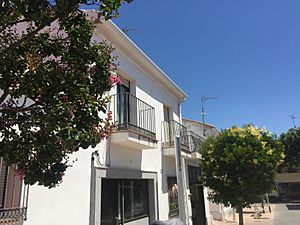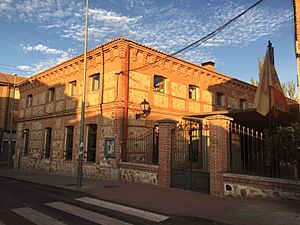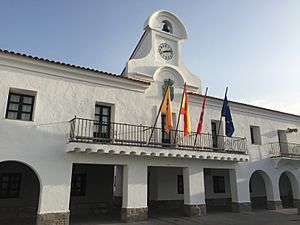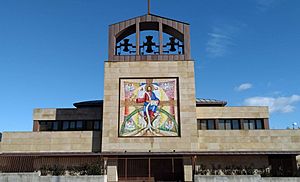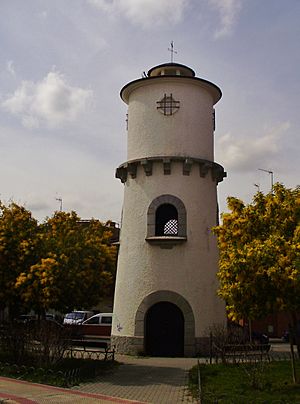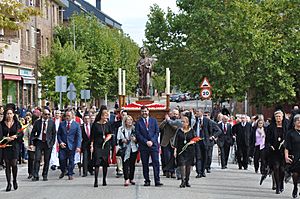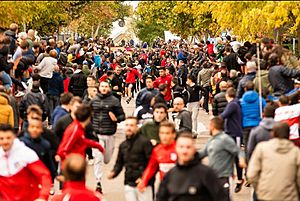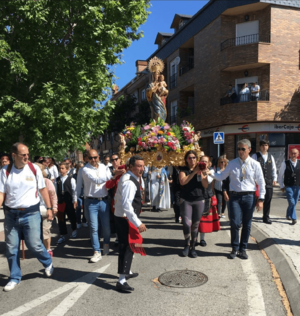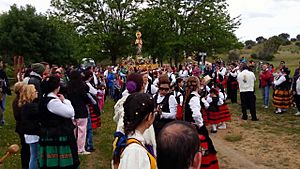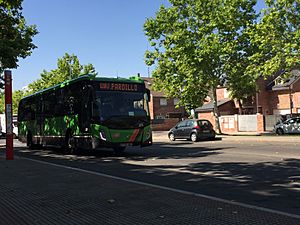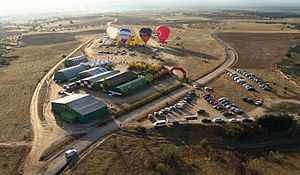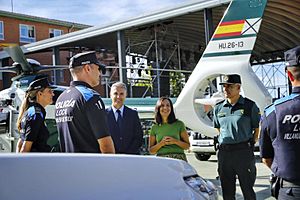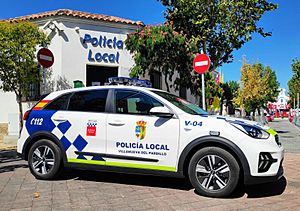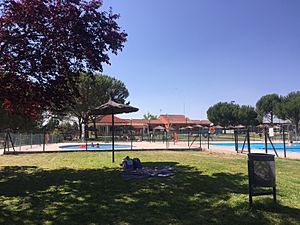Villanueva del Pardillo facts for kids
Quick facts for kids
Villanueva del Pardillo
|
|||
|---|---|---|---|
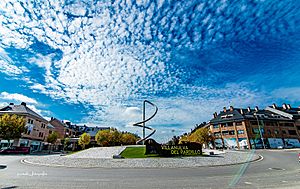 |
|||
|
|||
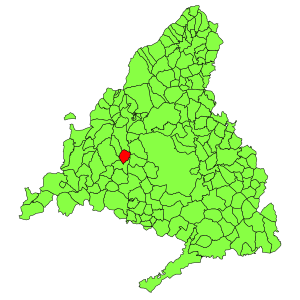
Municipal location within the Community of Madrid.
|
|||
| Country | |||
| Autonomous community | |||
| Government | |||
| • Type | Mayor–council | ||
| • Body | Ayuntamiento de Villanueva del Pardillo | ||
| Area | |||
| • Total | 9.79 sq mi (25.35 km2) | ||
| Elevation | 2,130 ft (650 m) | ||
| Population
(2018)
|
|||
| • Total | 17,127 | ||
| Demonym(s) | pardillano (m), pardillana (f) | ||
| Time zone | UTC+1 (CET) | ||
| • Summer (DST) | UTC+2 (CEST) | ||
| Postal codes in Spain |
28229
|
||
| Area code(s) | 34 (Spain) + 91 (Madrid) | ||
| Patron Saint | San Lucas | ||
| Patron Saint | Virgen del Soto | ||
| Twinned with Luisant and Chions | |||
Villanueva del Pardillo is a town in Spain, located in the Community of Madrid. It is about 26 kilometers (16 miles) from the capital city, Madrid. This town is surrounded by the beautiful nature of the Guadarrama River basin. It shares its borders with other towns like Majadahonda, Las Rozas de Madrid, Villanueva de la Cañada, Galapagar, Colmenarejo, and Valdemorillo.
Contents
Exploring Villanueva del Pardillo's Location
Villanueva del Pardillo is in the central part of the Community of Madrid. It lies west of the capital city. The town is also in the middle area of the Guadarrama River basin. Its elevation is about 650 meters (2,130 feet) above sea level. The eastern border of the town reaches the Guadarrama River.
| Northwest: Colmenarejo | North: Galapagar | Northeast: Las Rozas de Madrid |
| West: Colmenarejo y Valdemorillo |  |
East: Majadahonda |
| Southwest: Villanueva de la Cañada | South: Villanueva de la Cañada | Southeast: Villanueva de la Cañada |
Main Areas of the Town
Villanueva del Pardillo has several distinct areas:
- Urban Area: This is the main part of the town. Here you will find the Town Hall, schools, police offices, a cultural center, a sports center, and the public library. It has mostly apartments, but also some houses.
- Santa María Neighborhood: This area is about 1 km (0.6 miles) east of the main urban area. It is mostly made up of single-family homes. There is also a nursery school here.
- Las Vegas Neighborhood: Located 2 km (1.2 miles) east of the urban area, this neighborhood has mostly detached houses. Until 2006, it was considered a rural area. Now, it is a paved urban area. You can also find a paper recycling facility at the end of this neighborhood.
- Los Pinos: This area is just outside the main town, less than 1 km away. It is home to the Juan Manuel Angelina Municipal Football Field, a nursing home called Medinaceli, the Sapere Aude High School, and the Los Pinos Municipal Swimming Pool.
- Other important places
- Aulencia Business Park: This business park is located on the M-509 road, towards Villanueva de la Cañada.
- Priégola Farm: Another notable location in the area.
Nature and Environment
Guadarrama River Regional Park
The Regional Park of the Middle Course of the Guadarrama River and its surroundings is a special natural area. It has many different types of environments. The park stretches from the base of the Sierra de Guadarrama mountains to the plains of the Tagus River. It follows the path of the Guadarrama and Aulencia rivers.
This park is managed to allow people to enjoy nature while protecting it. It offers many activities related to fun, culture, and learning. The main goal is to teach visitors about the park's natural value so they will respect it. There are many rural paths and roads that were once used for farming and forestry. These paths now connect different towns.
The park also has special areas for recreation. These areas have signs with information and parking for cars. This helps visitors enjoy and learn about this unique natural space. There are also programs for environmental education. These programs help local residents get involved in protecting the park through fun activities. Studies on historical heritage are also done here. This includes making lists of old buildings and sites in the park.
Plants and Animals of the Region
Villanueva del Pardillo used to be a farming town with many cattle and sheep. Now, it has mostly become a residential area. The plants here include holm oaks, ash trees, willows, poplars, and elm trees. You can also find shrubs, grasslands, and different types of pine trees.
The animals in the area match these plants. You might see storks, tits, coalmen, finches, goldfinches, sparrows, and swallows. Because the town is in the Regional Park of the Middle Course of the Guadarrama River, it is a great place to see other animals. It is also perfect for walks, hikes, and other outdoor activities.
Town Symbols
On November 7, 1997, the official designs for the town's coat of arms and flag were published. Here are their descriptions:
- Town Coat of Arms
«The shield is split into two main parts. The top part has a blue background with three golden wheat ears. The bottom part is silver with a bunch of grapes. Below this, there is a diagonal cross shape. Two sections of the cross are green with a red stripe outlined in gold. The other two sections are gold with the words "Ave María Gratia Plena" (Hail Mary, Full of Grace). A Spanish Royal Crown sits on top.».
- Flag
«The flag has a size ratio of 2:3. It is a yellow cloth. In the very center of the flag, you will find the Town's Coat of Arms.».
Local Government
The Town Hall of Villanueva del Pardillo has 17 council members. These members are chosen by a public vote every four years. The mayor leads the town council. The council makes decisions in full meetings (plenary sessions) and through smaller groups (commissions).
After the local elections in May 2023, here is how the council members are divided by political party:
|
Town Hall of Villanueva del Pardillo 2023-2027 |
||||
| Political parties | Councilors | |||
| Partido Local (PLVP) |
|
|||
| PP |
|
|||
| Vox |
|
|||
| PSOE |
|
|||
Mayors of Villanueva del Pardillo
Since 2019, the mayor of Villanueva del Pardillo has been Eduardo Fernández Navarro from the Partido Local party. He currently leads with 7 council members.
| Name | Portrait | Office started | Office ended | Party affiliation | |
|---|---|---|---|---|---|
| Enrique González Palacios | 5 May 1974 | 15 June 1991 | FET y de las JONS (1974-1979) Independent (1979-1987) PSOE (1987-1991) | ||
| Juan González Miramón | 15 June 1991 | 13 June 2015 | PP |
||
| Luis Sosa Gayé | 13 June 2015 | 15 June 2019 | Ciudadanos |
||
| Eduardo Fernández Navarro | 15 June 2019 | Incumbent | Partido Local |
||
Historical Buildings and Sites
Buildings from the "Devastated Regions" Plan
After the Spanish Civil War, many buildings were constructed in Villanueva del Pardillo. These were part of the "Regiones Devastadas" (Devastated Regions) housing plan. The buildings were simple and inspired by traditional farmhouses. They usually had one or two floors facing the street. Even though many changes have been made over time, Villanueva del Pardillo's "Devastated Regions" town is one of the best preserved in the Community of Madrid.
The Master's House-Museum
This museum is currently being created. It aims to show what rural homes from the 1940s looked like. These homes were built as part of the "Devastated Regions" plan after the Spanish Civil War.
La Casona
The original design for "La Casona" dates back to around 1900. It was later restored between 1986 and 1989. After the Civil War, it served as a shelter for people who had lost their homes.
The ground floor of La Casona was used as a kitchen. Several families shared the rooms upstairs. The building's style mixes different historical elements. Its walls show a pattern of brick and stone, inspired by Neo-Mudéjar design. The windows are slightly arched with brick frames. This building is a great example of late 19th-century architecture.
Over its long history, the building has been used for many different purposes. Its inside layout and roof have also changed a lot. It has recently been renovated and is in excellent condition. "La Casona" is a protected building and is considered a cultural asset.
For many years, this building has been very important to the people of Villanueva del Pardillo. It has been a doctor's office, an Adult Education Center, and since 1991, a Cultural Center and Library. Today, it serves as the Municipal Library.
Plaza Mayor and Town Hall
The Plaza Mayor (Main Square) is the central part of the buildings from the "Devastated Regions" plan. It looks like a traditional Castilian square with arches, a fountain in the middle, and a south-facing view. The square is mostly square-shaped. Its main entrance is from the south, and it has two side entrances under arches. The Town Hall, which has been expanded at the back, stands proudly in the square. The first design for the square was in 1944, and the final one was in 1952. This area is a lovely example of the "Devastated Regions" style. It is very important to the town's citizens and is the best public space in Villanueva del Pardillo.
San Lucas Church
The San Lucas Church is in great condition because it was recently restored. It is an important landmark and cultural site for the town. This church, built in 1943, was also part of the "Devastated Regions" reconstruction. It has a U-shaped design. The parish center, rectory, and catechesis rooms are built around a cloister (an open courtyard with arched walkways). This courtyard opens onto a public square, which has an old well.
The church has one main nave (the central part of a church) with a sloped roof made of Arabic tiles. Its walls are brick with stone bases and supports. There is a square bell tower on one side. The church is a wonderful example of religious architecture from the "Devastated Regions" period and is well-preserved.
Water Tower
This water tower is perfectly preserved. It was part of the last projects from the "Devastated Regions" plan. Its purpose was to complete the shared water supply system called "River Aulencia Waters." It is a good example of public works architecture from that time.
Roman Archaeological Site Los Palacios
The Roman archaeological site called "Los Palacios" was first identified in the Archaeological Charter of the Region of Madrid. This happened after the Historical Heritage Law was published in 1985. In 2013, some parts of the site were dug up during a project by Canal de Isabel II Gestión. These excavations showed how valuable and important these ancient remains are.
Around the end of the 1st century AD, a Roman villa was built near the Palace stream. This villa was used until the end of the 4th century AD. A Roman villa was a type of farm in the countryside. Besides being the owner's home, it had buildings for processing products from the farm.
The part of the villa used for production is called the pars fructuaria. The buildings found during the archaeological dig belong to this part. Inside, archaeologists found a building that had a complete wine press (called a torcularium). It had all the necessary areas: a place for vineyards and storing grapes (a calcatorium), a pressing room, a pool for grape juice (a lacus), and the heavy weight that made the press work.
The torcularium in Villanueva del Pardillo is the first and only complete building of its kind found in the Region of Madrid so far.
Archaeology not only recovers old remains but also helps us understand how they relate to each other and to the time they were made. The items found tell us about eating habits, hygiene, or how advanced their production methods were. The remains also show how the landscape changed, and give clues about politics, economy, town planning, and art. In short, through archaeology, we learn about the different cultures that lived in our area long ago.
Local Celebrations
San Lucas Festivities
The celebrations for the town's patron saint, San Lucas, happen in mid-October (October 18). They start with a traditional announcement and a tasting of a popular stew. Then, there are fireworks, music shows, activities for children and teens, folk dances, and bullfighting events.
Virgen del Soto Pilgrimage
On the third Sunday of May, the day of the Virgen del Soto, the patron saint of Villanueva del Pardillo, is celebrated. It is a tradition to have a procession with the Virgin to a place called Fuente del Manchego. This is where the town's hermitage (a small chapel) is located. Religious events are joined by folk dances, music performances, and traditional games.
In 1995, the people of Villanueva del Pardillo chose their future patroness. They did this in a very democratic way: by putting a coupon with the name of their chosen virgin into a ballot box.
This is how the Virgen del Soto was chosen. The idea came from a group of local women. They suggested to the mayor that a new hermitage should be built. This would create another official celebration besides the San Lucas festivities in October.
- Results of the 1995 Referendum for the Patroness of Villanueva del Pardillo
The Virgen del Soto won with 98 out of 166 votes. The Virgen del Valle received 45 votes, Our Lady of Fatima got 11 votes, and the Virgen del Rocío had six votes. Our Lady of Victory was chosen by four people, and Santa Claudia received only one vote. Santa Joaquina's name did not get any votes.
Other Celebrations
- San Antón (January 17): A traditional blessing of animals.
- San Sebastian (January 20): A festival celebrating local traditions. Activities include reading popular sayings, dances, and the unique "Dance of the Button" contest.
- Carnival (February): Features a parade, children's shows, a costume contest, and the traditional "burial of the sardine."
- Day of the Letters (April): This day celebrates literature. The winner of the Villanueva del Pardillo Short Novel Prize is announced.
- Medieval Market (April): This event recreates the medieval period. It features musicians, acrobats, artisans, and comedians around the Plaza Mayor.
- San Isidro (May 15): Highlights include a traditional display of farm tools in the Plaza Mayor, dancing, and snacks. Religious ceremonies also take place.
- Summer Nights (July and August): Different outdoor activities are held. These include dance, theater, puppet shows, magic, and movie premieres.
- Festivities (four days, always including October 18): These are held in honor of the town's patron saint, "San Lucas." There are fireworks (except in 2009) and a fair with rides. On October 18, Saint Luke's Day, a mass and procession are held for the saint.
- Traditional Pig Slaughter (November): This old tradition has been brought back. It is passed down from parents to children. This way, young people learn the traditional way of making different pork products.
- Christmas (December–January): Includes a Christmas concert, the Kings parade, Christmas Eve parties, and New Year's Eve celebrations.
Food and Drink
Villanueva del Pardillo, like nearby towns, offers a typical and varied cuisine. The influence of the Sierra de Guadarrama means that many dishes feature local meats and desserts.
Every year, the town council organizes the "Ruta del Tapeo" (Tapas Route). This event promotes local restaurants and their creative dishes. Also, "Gastronomic Days" have been organized five times. These events highlight and promote typical dishes from the area.
Traditions
Villanueva del Pardillo is also known for its Castilian dances. These dances come from Segovia, mainly "jotas" and "rondones." Over time, they have been influenced by other styles, and now include "seguidillas." On the third Sunday of May, the traditional pilgrimage of the "Virgen del Soto" takes place. During this event, people walk through the streets, accompanied by the sounds of drums and dulzainas (a type of wind instrument).
Getting Around: Transport and Roads
Roads Connecting the Town
The following roads pass through Villanueva del Pardillo:
 The regional road M-509 goes through the center of the town. To the east, it connects with the M-50 Bypass road and the towns of Majadahonda and Las Rozas de Madrid. It also helps people reach neighborhoods further from the town center. To the west, it connects with the M-503 road and leads to Los Pinos and Aulencia's Business Park.
The regional road M-509 goes through the center of the town. To the east, it connects with the M-50 Bypass road and the towns of Majadahonda and Las Rozas de Madrid. It also helps people reach neighborhoods further from the town center. To the west, it connects with the M-503 road and leads to Los Pinos and Aulencia's Business Park.
 The regional road M-503 runs for 3 kilometers (1.8 miles) within the town. To the west, it connects with the M-600 road and the towns of Villanueva de la Cañada and Valdemorillo. To the southeast, it connects with the southern part of Majadahonda.
The regional road M-503 runs for 3 kilometers (1.8 miles) within the town. To the west, it connects with the M-600 road and the towns of Villanueva de la Cañada and Valdemorillo. To the southeast, it connects with the southern part of Majadahonda.
- M-851 : The regional road M-851 goes through the town of Majadahonda. It connects Las Rozas with Villanueva del Pardillo. It starts at kilometer 3 of the M-505 road and ends at the M-509 road.
Bus Services
Villanueva del Pardillo has a bus service with eight intercity lines. These lines connect the town with Majadahonda, Las Rozas de Madrid, Villanueva de la Cañada, Valdemorillo, Brunete, and Colmenar del Arroyo. Five of these intercity lines connect directly to Madrid, ending at the Moncloa Interchange.
| Transport mode | Line | Route | Operator |
|---|---|---|---|
| 626 | Las Rozas - Majadahonda - Villanueva de la Cañada | Auto Periferia S.A. | |
| 626A | Majadahonda (Railway Station) - Villanueva del Pardillo | ||
| 627 | Madrid (Moncloa) - Villanueva de la Cañada - Brunete | ||
| 641 | Madrid (Moncloa) - Valdemorillo | Julián de Castro, S.A. | |
| 642 | Madrid (Moncloa) - Colmenar del Arroyo | ||
| 643 | Madrid (Moncloa) - Villanueva del Pardillo | ||
| FS1 | Las Rozas (CC Herón City/Las Rozas Village) - Valdemorillo | ||
| N908 | Madrid (Moncloa) - Villanueva del Pardillo - Valdemorillo |
Please note: On line 627, you cannot travel directly between Madrid and Villanueva del Pardillo.
Aerodrome
In 1978, two brothers started the first aeroclub in Spain at the Villanueva del Pardillo aerodrome. Today, it is a pilot school. It offers courses and flights in balloons and ultralight aircraft. The aerodrome also sells aircraft and provides maintenance and repair services.
The Villanueva del Pardillo airfield has a runway made of compacted gravel. It is 400 meters long and 25 meters wide.
- U.L.M. Villanueva del Pardillo School*
- Coordinates: 40°30 10 N 3°59 58 O*
- Elevation: 678 m / 2237 ft*
- Frequency: 130.125hz*
Community Services
Local Justice System
Villanueva del Pardillo is part of Madrid's judicial district number 7. This district is based in San Lorenzo de El Escorial, where there are several courts. In Villanueva del Pardillo, there is a magistrate's court located at Rio Manzanares Street, 2. A magistrate handles the legal duties for this area.
Safety and Security
The Department of Citizen Security works closely with the community. It helps prevent and respond to issues. This department is in charge of safety, surveillance, traffic, accident assistance, and helping to solve conflicts.
This department includes the Local Police and Civil Protection. Within these, there are special units. These include units for Gender Violence, Tutors, Administrative Police, Traffic and Road Education, Environment, Dog Guides, and Communication.
Since April 2022, a Guardia Civil (national police force) office has been operating within the local police units. People can go there to file complaints or for other procedures. It is open from 8:00 AM to 2:00 PM, Monday to Friday.
Social Services
Since 1991, social services in Villanueva del Pardillo have been provided by the Commonwealth of Social Services La Encina. This group offers shared services to Villanueva de la Cañada, Villanueva del Pardillo, Brunete, and Quijorna. The Commonwealth provides public services through a team of social workers. These professionals help improve social well-being. They work to prevent, remove, or treat problems that stop individuals or groups from fully developing.
The main office is in Villanueva de la Cañada, at the El Molino Civic Center. They provide social care there for residents of Villanueva de la Cañada. In other towns, services are offered at special units. In Villanueva del Pardillo, the office is located in the Senior Center. Since 2019, the Social Services Councillor of Villanueva del Pardillo has been the vice-president of the Commonwealth. Villanueva de la Cañada holds the presidency.
Education
Villanueva del Pardillo has one public nursery school, E.I. Virgen del Soto. There are also seven private nursery schools. For primary education, there are three public schools: San Lucas, Rayuela, and Carpe Diem. Additionally, there are two private schools: Vallmont College and Antavilla School. The town also has one public bilingual high school, Sapere Aude.
There is an organization called Pardillo Verde. Its main goal is environmental education. All schools in Villanueva del Pardillo and nearby areas can use its resources.
Culture
Villanueva del Pardillo offers many cultural activities. These include Municipal Schools for Music, Dance, Crafts, and Theatre. Throughout the year, there are also workshops, talks, exhibitions, concerts, and shows for all ages.
Sports Facilities
The town has several sports facilities:
- Sports Center Mayor Carlos Hipólito (Los Pinos)
- Infanta Cristina Sports Center
- Juan Manuel Angelina Soccer Field
- Jesús Rollán Indoor Pool
- Track and field area
- Outdoor pools (3 different pools)
- 5 tennis courts
- 4 paddle tennis courts
- 2 beach volleyball fields
- 5 multi-purpose sports courts
- BMX track
See also
 In Spanish: Villanueva del Pardillo para niños
In Spanish: Villanueva del Pardillo para niños



